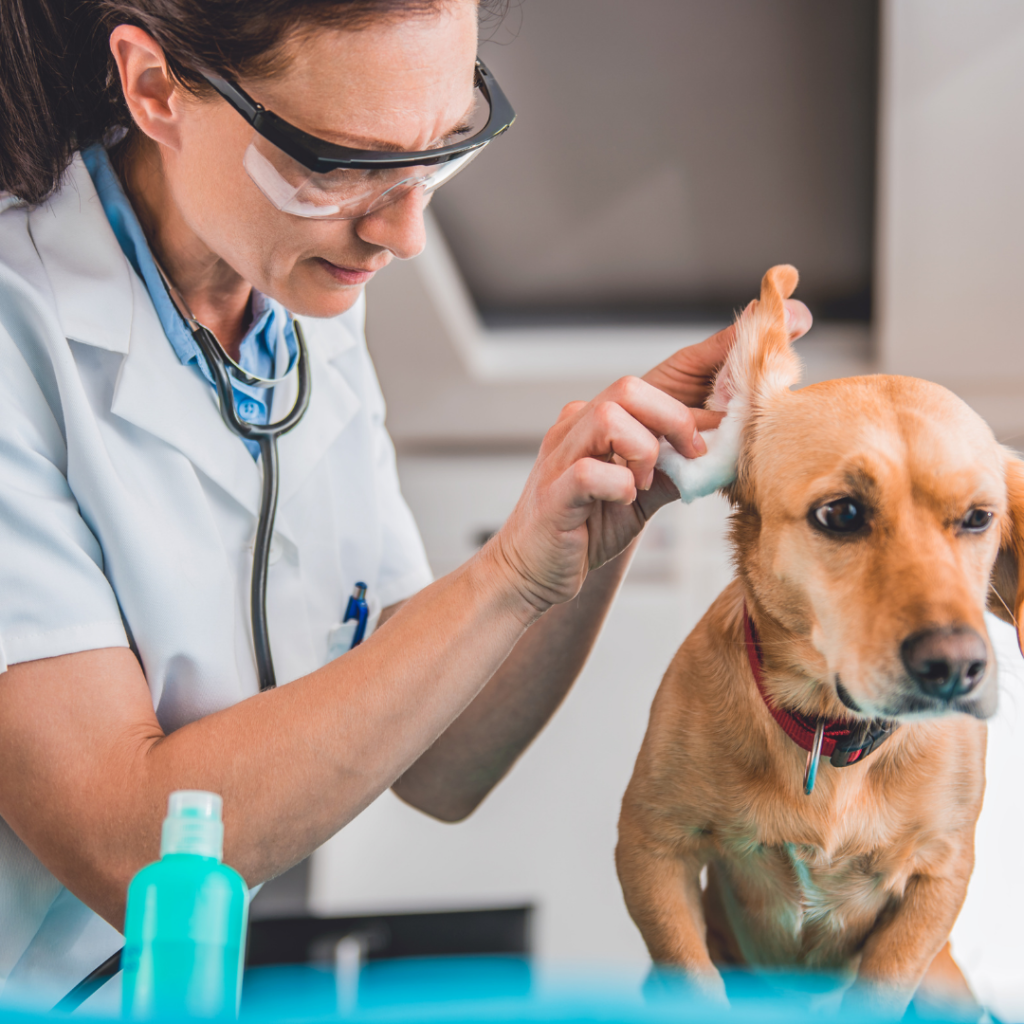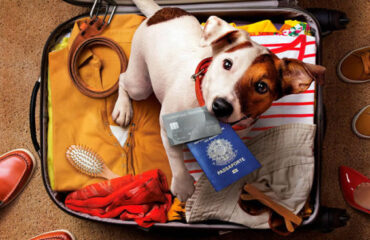
earache affects dogs and cats and can appear on several occasions, especially during a flight lasting several hours.
Going on a plane trip with pets has become increasingly common. However, the experience may not be so good for pets for a variety of reasons.
In other words, the long period closed in the transport box or in the aircraft hold can be quite stressful and make them present behavior changes.
Still, the situation can get even more complicated if they have otitis, an infection caused by the accumulation of wax or water in the ear. This condition if left untreated can lead to the pet’s death.
So, if you want to know more about earache in dogs and how to avoid it while traveling, keep reading this article that a PET Friendly Turismo prepared to answer all your questions.
What is canine otitis?

Otitis externa, as the earache in dogs is also known, is an infection that affects the animal’s ear canal. It can be caused by both internal and external agents.
Bacteria, natural fungi and important mites for the organism live in the ears of pets.
However, when the pet’s immunity drops, they reproduce more than necessary and end up causing the infection.
The entry of water into the ear canal, especially during bathing, or the presence of foreign bodies (such as cotton and dirt) are factors that contribute to the appearance of otitis.
It can still be provoked by the mania that some dogs have of licking each other’s ears.
In addition, earachein dogs and cats is also associated with glandular disorders and autoimmune or viral diseases.
Puppies of the Cocker Spaniel, Basset, Golden Retriever and Beagle breeds are more likely to have this infection.
Their long, drooping ears make it difficult to ventilate the ear canal, increasing the proliferation of bacteria, fungi and mites.
Cats can also suffer from earache caused by ear infections, but the anatomy of their ears makes these infections more rare.
What are the consequences of earaches in dogs?

The infection can develop into otitis interna, which in turn ruptures the tympanic membrane and affects its balance.
These conditions can cause a vestibular syndrome, which causes the animal to walk in circles and tilt its head only to one side.
The earache in dogs if left untreated can cause partial or total loss of hearing in pets.
It can still cause widespread infection, reaching the liver, heart and even the nervous system. In some cases, it can even kill the pet.
Symptoms of animal otitis
A pet that is aggressive to the touch of its ears, that has excessive itching or local redness may have an earache.
Yellow colored secretions and crusting are also indicative of infection, as are:
- Shaking your head frequently;
- Rubbing your ears on the floor repeatedly;
- Loss of appetite;
- Having a strong smell in the region of ears.
How does earache occur in dogs traveling by plane?
As with humans, animals can also experience barotrauma when traveling by plane.
This injury is caused by an imbalance between the environmental pressure inside the aircraft and the pressure inside the middle ear cavity.
As the plane gains altitude, atmospheric pressure reduces inside the cabin and causes the gases inside the middle ear to expand.
This increased pressure is drained to the environment by the Eustachian tube, which opens into the nasal portion of the pharynx.
On landing, when the plane loses altitude, there is a contraction of the volume of gases inside the middle ear and the person has to command the opening of the tube.
This is necessary for air to enter the middle ear.
How to prevent earache in a dog from appearing while traveling by plane?
Some attitudes can minimize the earache of dogs or cats during a plane trip, especially those caused by infections.
Cleaning the animals’ ears properly and removing the wax buildup are some actions that need to be done a few days before the flight. Check it out:
1. Perform proper hygiene
Lack of hygiene or excessive hygiene are risk factors for the onset of earache in dogs.
Without proper cleaning, wax, dirt or any secretion can accumulate in the dog’s or cat’s ear and, in this way, clog their ear.
Exaggerated hygiene, without drying properly, can remove the body’s natural defenses and leave the pet with low immunity, which causes the appearance of infections.
In addition, the water accumulated during the bath is also responsible for the appearance of animal earache.
2. Don’t forget to bath and tosa

The ideal is to clean the ear area a few days before the plane trip, thus avoiding pain during the flight.
Take your pet to a trusted location. At bath time the ears need to be protected to prevent moisture.
Floppy, furry-eared animals, on the other hand, need to be clipped frequently. Excess hair accumulates dirt and moisture, facilitating the appearance of otitis.
Now, if your pet doesn’t have a lot of hair, avoid removing the ear hair. They are essential to protect the animals’ ear canal.
3. Remove wax
Before the trip, make sure the dog or cat does not have earwax. Even with proper and frequent cleaning, it can still accumulate.
In these cases, you will need to apply a cleaning solution recommended by your trusted veterinarian. This product usually breaks the cerumen and rebalances the pH of the region.
To perform the procedure at home, lay the animal down and apply the solution to its raised ear.
Then, massage and clean the area with a soft cotton gauze to absorb any liquid from the area.
Do not use cotton swabs as they can push the wax further or hurt your pet’s ear.
4. Keep the animal calm
Animals can also suffer the effects of atmospheric pressure, like humans, and may present:
- mild ear pain;
- decreased hearing;
- tinnitus.
For this reason, it is important that the dog or cat is calm during the trip, especially if it is long.
This way, start training the animal so that it stays in the carrier a few months before the flight.
Put toys or treats inside and gradually make him eat meals in the closed kennel. Also, make sure he stays calm while he’s in the crate.
On the day of the flight, keep the animal calm. Provide light food and walk around the airport so that the animal gets used to the movement.
Although it is necessary to arrive at the airport in advance, do not tie up or dispatch the dog or cat too early, as this can make the experience even more stressful.
The less time they are trapped, the better.
5. Do not apply sedative
Some errors common committed by owners is to sedate or give tranquilizers to animals so that they can travel by plane.
However, the administration of these drugs can cause side effects, such as excessive sedation, muscle relaxation or even paradoxical excitement and anxiety.
In case of turbulence, the dog or cat cannot protect itself if it is sedated.
In addition, they may behave differently than usual when waking up in mid-flight and not recognizing where they are.
Therefore, only administer motion sickness medication or tranquilizers if they are prescribed by the veterinarian who normally sees your pet.
Is it possible to prevent earache in a dog from being caused while traveling?

Earache caused by turbulence or atmospheric difference are more difficult to avoid.
After all, there is no way to predict when and how they will affect pets.
However, dog earache caused by infections, either by parasites or even accumulation of wax and dirt can be prevented.
A plane trip tends to be very long, which can make the animal very stressed. If he feels pain, the experience becomes even worse.
Therefore, pets need to be healthy and calm so they don’t suffer so much during the trip.
Now, if you still have questions about traveling with dogs and cats to other countries or how to ship them as cargo, contact PETFriendly Tourism.
We offer several services thinking about your animal’s well-being and safety throughout the trip.





You must be logged in to post a comment.